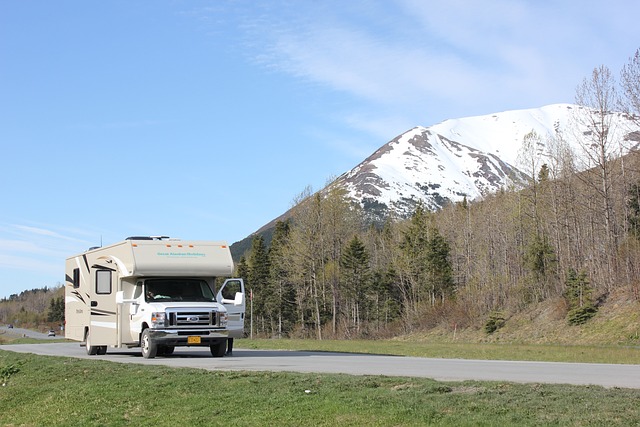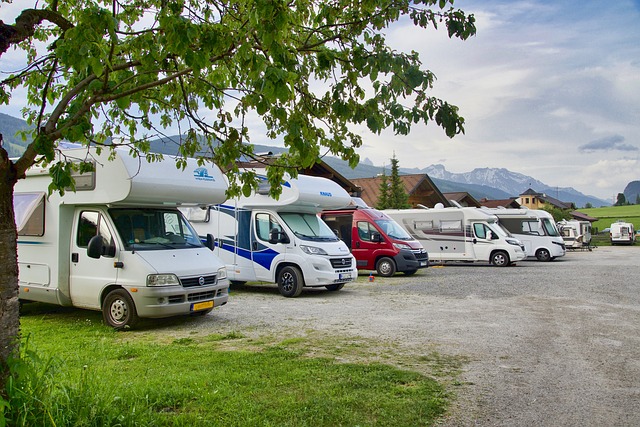embarking on an RV adventure, it's crucial for beginners to have a solid preparation plan using the RVing for Beginners guide. This includes understanding your RV's systems and layout, as well as having all essential supplies like leveling blocks, hoses, and cords ready for setup at your chosen campsite. Secure your RV's position with leveling blocks to avoid leaks and ensure appliance functionality. Properly connect sewer, water, and electricity services, making sure they match your RV's specifications. After setting up, verify the electrical appliances are working, then enhance your campsite's comfort by using outdoor gear, awnings, and patio furnishings. Always adhere to campground rules and maintain a clean site for future travelers. Essential equipment such as a quality sewer hose, propane detector, power inverters, fresh water hoses, extension cords, a surge protector, waste master valve, and an RV atlas or navigation app are indispensable. Remember to level your RV, test all systems, and have a fire extinguisher for safety. With careful planning and attention to detail, your RVing for Beginners experience can be both safe and enjoyable, setting the stage for many adventures on the road.
Embark on a camping adventure with confidence using our beginner-friendly guide to RVing. This comprehensive article demystifies the process of setting up camp, ensuring your first RV journey is smooth and enjoyable. We’ve compiled essential equipment checklists and tips tailored for novice RVers. Dive into the world of outdoor living, where nature meets comfort in the perfect blend for memorable trips. Whether you’re a seasoned caravaner or a complete newcomer, these step-by-step instructions will transform your camping experiences.
- Getting Started with RVing for Beginners: A Step-by-Step Guide to Setting Up Camp
- Essential Equipment Checklist and First-Time Setup Tips for RVers
Getting Started with RVing for Beginners: A Step-by-Step Guide to Setting Up Camp

Embarking on your first RV adventure can be both exhilarating and intimidating, but with the right preparation and understanding of the basics, you’ll be well on your way to enjoying the great outdoors in comfort and style. Before you set out, familiarize yourself with your RV’s layout, understand how systems like water, electricity, and sanitation work, and ensure you have all necessary supplies, including a leveling block kit, sewer hoses, water hoses, and extension cords. Upon arrival at your campsite, the initial setup process is crucial to ensure safety, comfort, and adherence to campground rules. Begin by scouting the area for the best spot, considering proximity to facilities and privacy. Use leveling blocks under the wheels or axles opposite each other to stabilize the RV and prevent interior damage from uneven ground. Connect your sewer hose to the appropriate outlet at the campsite, followed by a water hookup to ensure fresh water access and drainage of grey and black water. Plug into the electrical service provided, using the correct amp and voltage compatibility for your RV’s system. Once connected, turn on your RV’s water pump and test all appliances that require electricity to confirm they are functioning properly. With your RV now securely set up, you can focus on setting up your campsite, including unloading outdoor gear, awning deployment for additional shade or shelter, and arranging patio mats or furniture to make the most of your outdoor living space. Remember to follow all campground rules and leave your site better than you found it for future campers. By following these steps, RVing for Beginners can become a rewarding and enjoyable experience that opens up a world of travel opportunities.
Essential Equipment Checklist and First-Time Setup Tips for RVers

Embarking on your first RV adventure can be both exhilarating and daunting, but with the right equipment and setup knowledge, you’re set for a comfortable journey. A well-prepared checklist of essential equipment is crucial for RVers, especially those who are new to RVing for Beginners. This checklist typically includes the following items: a leveling block to ensure your RV is stable on varied terrains, a reliable toilet for self-contained facilities, a propane detector for safety, a power inverter to convert DC to AC for all your electrical needs, and a quality sewer hose with gloves for maintenance. Additionally, don’t forget the basics like fresh water hoses, extension cords, surge protector, waste master valve, and a reliable RV atlas or navigation app tailored for RVers.
When setting up camp for the first time, it’s beneficial to follow some first-time setup tips for RVers. Begin by leveling your RV using the leveling blocks to prevent interior leaks and to ensure appliances function correctly. Next, familiarize yourself with the RV’s electrical system, connecting the water, sewer, and waste tanks appropriately. Take the time to test all systems, such as the water pump, AC units, furnace, and refrigerator, to confirm they are operational. It’s also wise to set up your awning and patio mat for additional living space and protection from the elements. Lastly, ensure that you understand how to use the RV’s propane system safely, and always keep a fire extinguisher within reach. By following these steps, RVers can confidently establish a comfortable and functional home away from home, making their RVing for Beginners experience a memorable and positive one.
Embarking on your first RV camping journey can be an exhilarating adventure, and with the right preparation, it’s also a smooth one. This guide for RVing beginners has outlined a comprehensive step-by-step process to confidently set up camp, complete with an indispensable equipment checklist and practical first-time setup tips. By following these instructions, you’re well-equipped to embrace the RV lifestyle and make the most of your travels. Remember, the joy of RVing for beginners is in the journey and the experiences along the way. Safe travels and happy camping!
